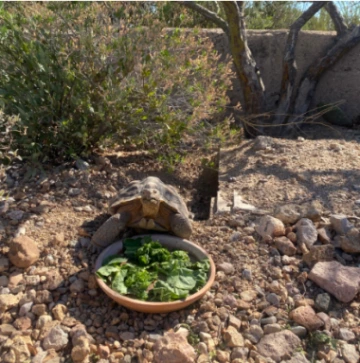Desert Explorers

The Sonoran Desert, spanning parts of Arizona, California, and Mexico, is an arid and rugged landscape known for its extreme temperatures and unique biodiversity. Surviving in the Sonoran Desert requires special adaptations and amidst this harsh environment, a group of extraordinary creatures thrives – the desert tortoises. In this blog post, we'll delve into the fascinating world of these resilient reptiles.
Desert Dwellers: Meet the Desert Tortoise
- Gopherus agassizii: The Sonoran Desert is home to the desert tortoise (Gopherus agassizii), a species well-adapted to extreme conditions. These tortoises are known for their robust, domed shells and can live for several decades or even up to a century.
- Life in Slow Motion: Desert tortoises are known for their slow and deliberate movements. They have adapted to conserve energy in the arid landscape, which helps them survive on limited resources.
- Burrow Builders: To escape the heat of the day and harsh weather, desert tortoises dig burrows in the desert soil. These burrows provide a stable microclimate, helping them regulate their body temperature and stay cool.
- Water Storage: Desert tortoises have the unique ability to store water in their bladders. During the rare occasions when they encounter water, they can absorb and store it in their bodies, which allows them to survive for extended periods without access to fresh water.
Threats to Survival
While desert tortoises have evolved to withstand the desert's challenges, they face numerous threats to their survival:
- Habitat Loss: Urbanization and human development encroach on their habitat, leading to habitat destruction and fragmentation.
- Disease: Upper respiratory tract disease (URTD) has had a significant impact on tortoise populations in recent years. URTD shows in desert tortoises as a mild to severe nasal discharge and other symptoms such as puffy eyelids and dullness in skin could arise. This disease can be deadly and is transmitted through contact with already infected tortoises.
- Predation: Coyotes, ravens and other predators pose a threat to young tortoises in the Sonoran Desert.
Conservation Efforts
Efforts are underway to protect and conserve these iconic desert dwellers:
- Rescue and Rehabilitation: Organizations and wildlife agencies work to rescue and rehabilitate injured or sick tortoises, returning them to the wild when possible. If you find a tortoise in need of help in the Tucson area, please contact the Tucson Wildlife Center.
- Habitat Preservation: Conservationists are actively working to protect and restore the desert tortoise's natural habitat, ensuring it remains intact for future generations.
- Research and Education: Scientists study these creatures to better understand their behavior and needs. Education initiatives aim to raise awareness about the importance of desert tortoises and their fragile environment.
Visit and Learn
If you're interested in observing these incredible reptiles in their natural habitat, several wildlife sanctuaries and parks in the Sonoran Desert offer opportunities for visitors to learn about and appreciate desert tortoises. We at the Cooper Center have a desert tortoise named Momo and we also have many wild ones that we see along our hikes around camp.


